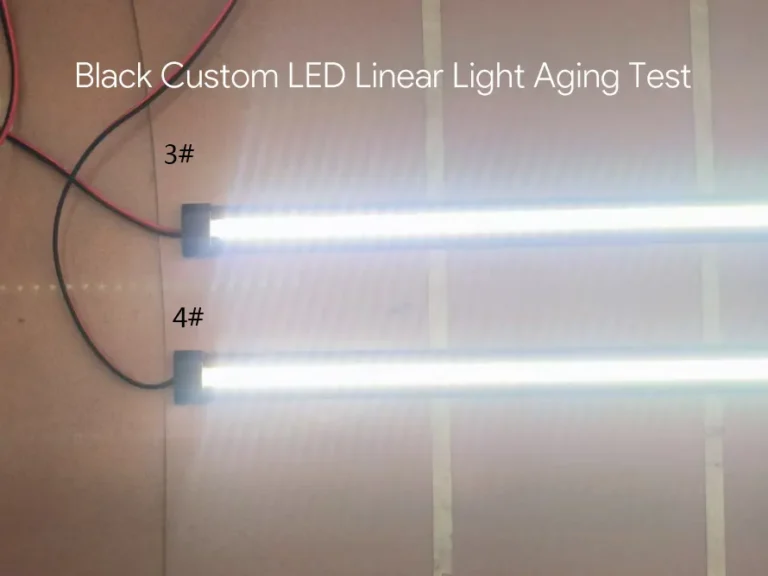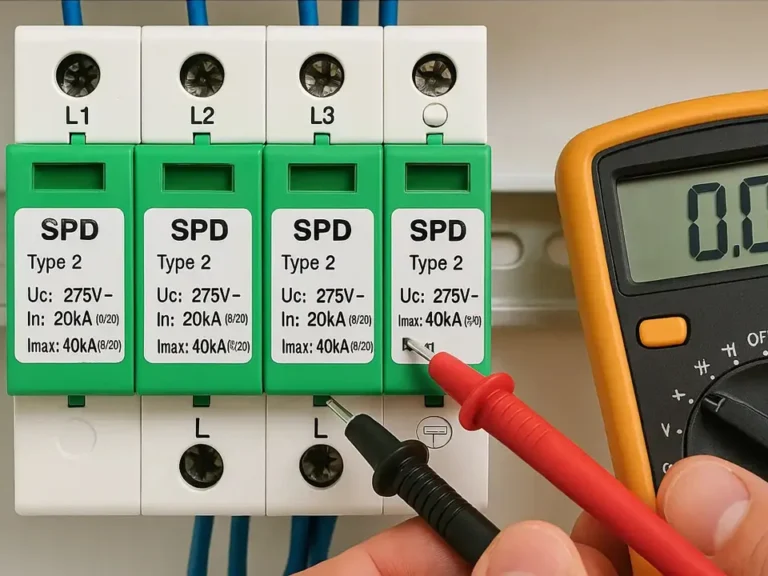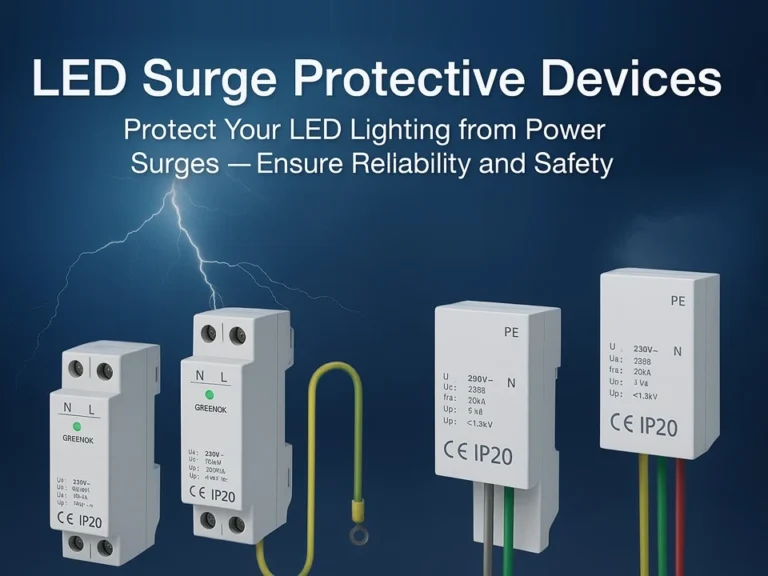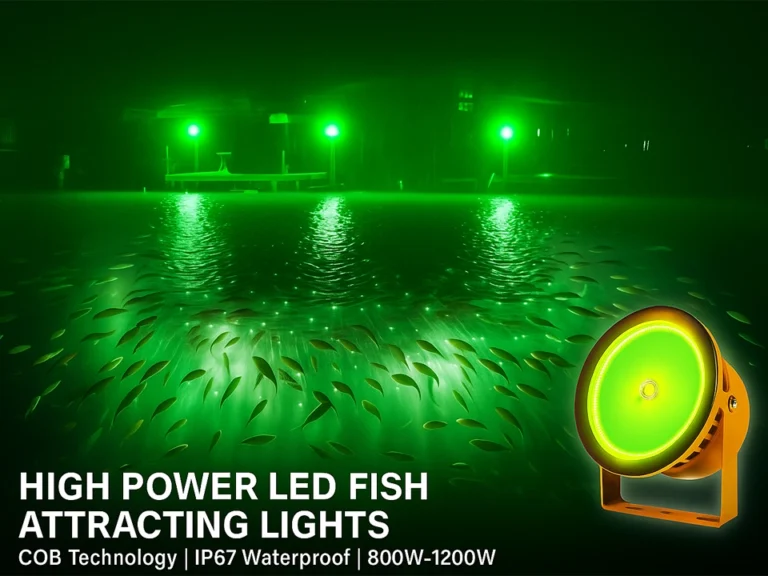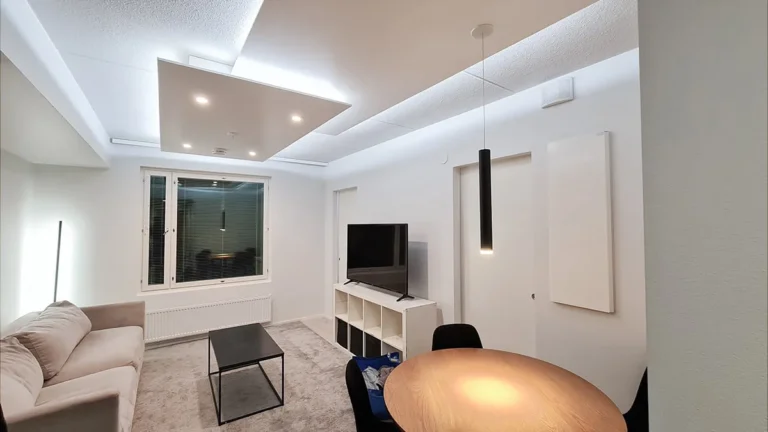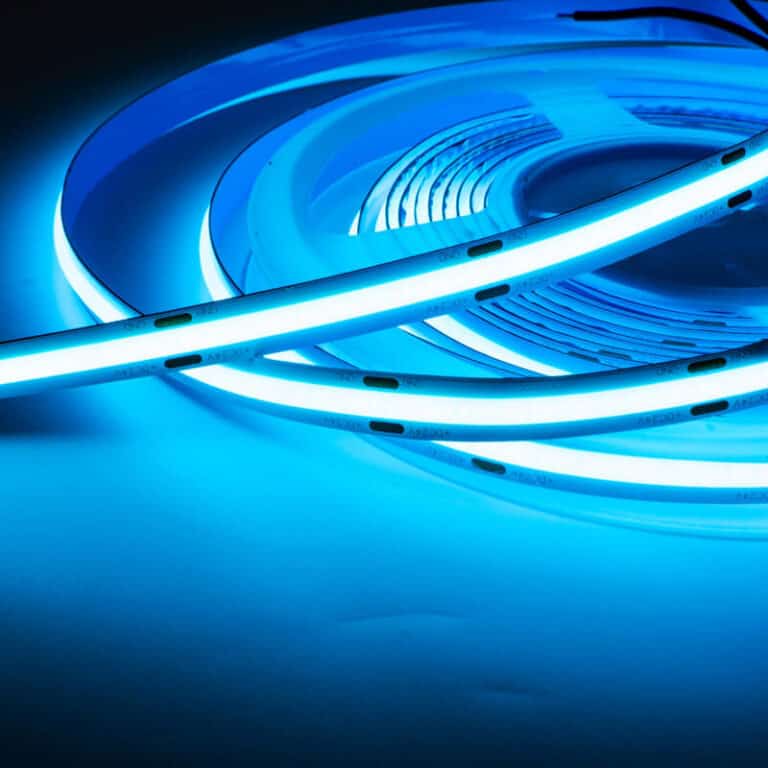오늘날의 고도로 전기화되고 디지털화된 세상에서 우리 사회는 가정의 스마트 TV 및 컴퓨터에서 산업 환경의 정밀 제어 장치에 이르기까지 취약한 전자 장치에 의존합니다.
그러나 보이지 않는 위협이 전력망 내에 도사리고 있습니다. 바로 전기 서지입니다. 이들은 100만 분의 1초 이내에 막대한 피해를 입힐 수 있습니다. 서지 보호 장치 (SPD) 이 위협에 대한 중요한 방어 역할을 합니다. 그러나 모든 SPD가 동일하게 생성되는 것은 아닙니다.
유형 1, 유형 2 및 유형 3 SPD의 차이점을 이해하는 것은 포괄적이고 효과적인 서지 보호 시스템을 구축하는 데 필수적입니다. 이 기사에서는 이 세 가지 SPD 범주의 역할, 표준 및 응용 프로그램을 검토하여 강력한 전자 방어를 구축하는 데 대한 완전한 지침을 제공합니다.
서지 보호 장치(SPD)란 무엇입니까?
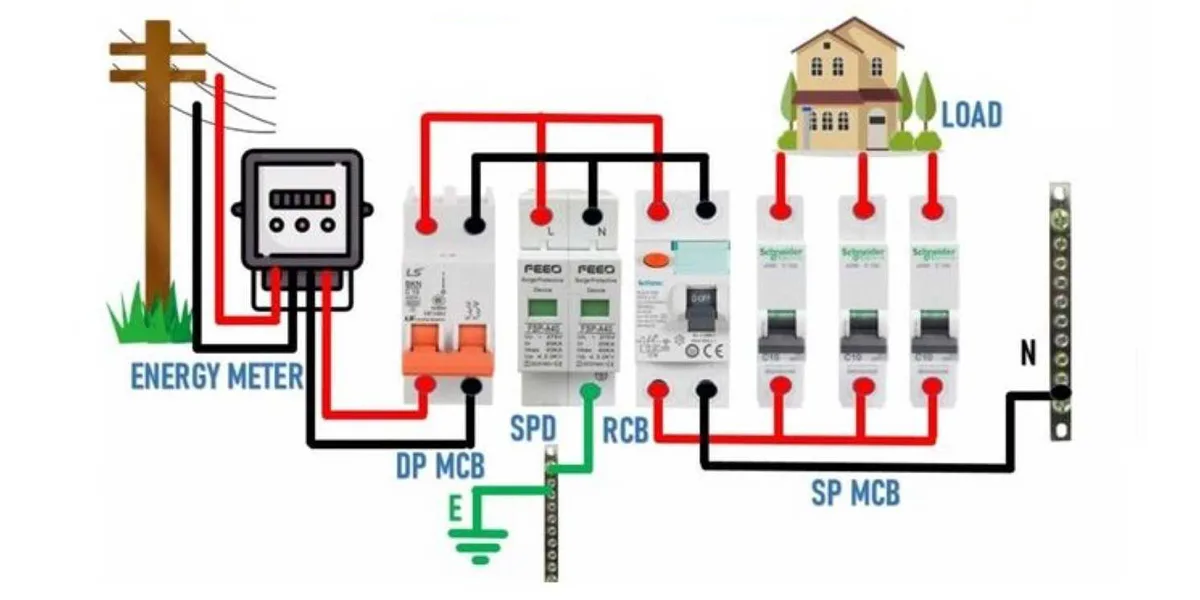
서지는 어디에서 오는가?
과도 과전압이라고도 하는 서지는 천문학적 지속 시간(마이크로초에서 밀리초)이지만 전압 진폭은 정상 작동 수준을 훨씬 초과하는 전류 펄스를 나타냅니다. 크게 두가지로 나눌 수 있으며, 외부 서지와 내부 서지의 두 가지 유형이 있습니다.
외부 급증(기본 위협)
a) 직접 번개: 번개 타격 전력망 또는 인근 구조물은 수백만 볼트를 주입합니다. 이는 가장 극단적인 시나리오입니다.
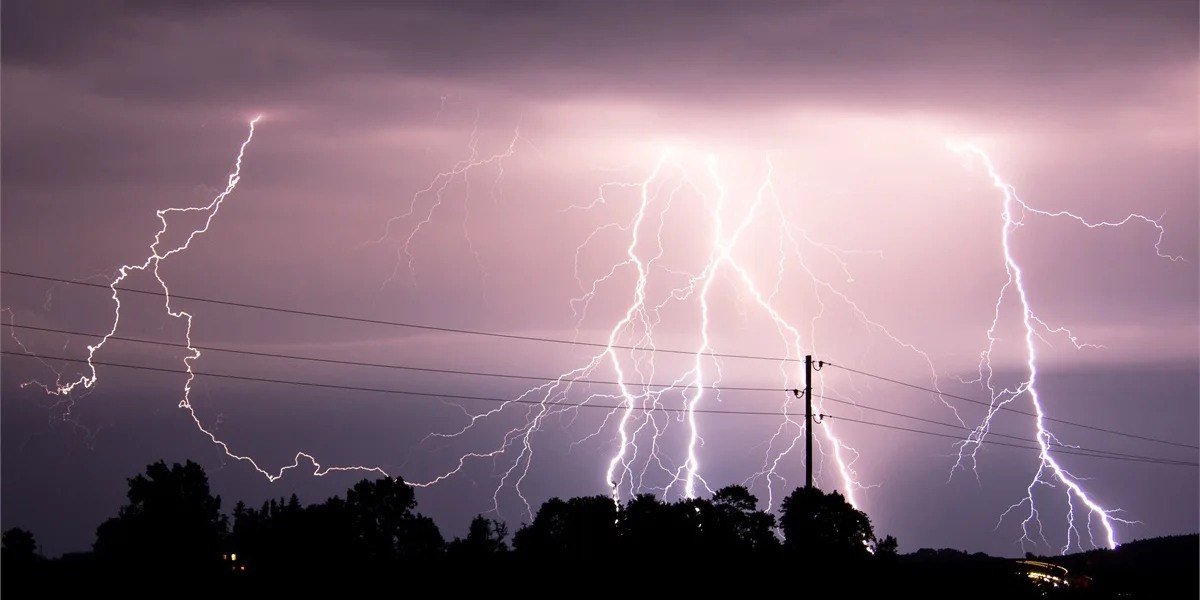
b) 유도 번개: 더 일반적입니다. 수백 미터 떨어진 곳에서도 번개가 치는 경우에도 강력한 전자기장이 실내 전력 및 신호선에 과전압을 유도하여 장비로 전파됩니다.
내부 서지(자주 발생)
엘리베이터, 에어컨 컴프레서, 용접기 등 건물 내 고출력 장비의 전환 작업은 전력망에서 잦은 스위칭 과도 현상을 생성합니다. 복사기 및 커피 기계와 같은 작업도 빈번하고 에너지가 낮은 과도 과전압을 생성합니다.
이러한 서지의 누적 효과는 "미니어처 해머"와 같은 역할을 하며 전자 부품을 지속적으로 강타하여 점차 성능 저하, 데이터 손상 및 장비 수명 단축을 유발합니다. 그러나 하나의 주요 급증 이벤트는 즉시 영구적인 장비 손상을 일으키거나 화재를 유발할 수 있는 "전자 심장마비"와 유사합니다.
SPD(Surge Protective Devices)는 이러한 위협에 대응하기 위해 특별히 설계된 전자 안전 장치입니다. 핵심 기능은 “모니터, 다이버트, 클램프”로 요약할 수 있습니다.
정상 전압 조건에서 SPD는 회로에 영향을 미치지 않는 높은 임피던스를 나타냅니다. 과전압을 감지하면 나노초 내에 저임피던스 상태로 전환되어 서지 전류에 대한 접지에 대한 안전한 방전 경로를 설정하면서 단자(클램핑 전압)를 보호하는 장비의 허용 오차 내에서 안전한 범위로 제한합니다.
따라서 SPD는 자산을 보호하고 비즈니스 연속성을 보장하며 데이터를 보호하려는 현대적인 전기 시스템에서 사치품이 아니라 필수적인 구성 요소입니다.
SPD는 어떻게 작동합니까?
정상 조건에서 SPD는 회로에 영향을 미치지 않으며 높은 임피던스 상태를 유지합니다. 위험한 서지가 감지되면 나노초 이내에 반응하여 저임피던스 상태로 전환됩니다. 이것은 서지 전류에 대한 낮은 저항 경로를 생성하여 빠르게 "회전"하는 동시에 단자(클램핑 전압이라고 함)의 전압을 안전한 범위로 제한합니다. 이렇게 하면 병렬로 연결된 장비가 손상되지 않도록 보호합니다.
다음과 같이 고전압 수류를 위한 지능형 압력 릴리프 밸브로 시각화할 수 있습니다. 수압이 정상일 때 밸브는 단단히 닫혀 있습니다. 압력이 갑자기 급증(서지)되면 밸브가 즉시 열리고 과도한 물 흐름(서지 전류)을 방출하여 다운스트림 장비(귀하의 기기)의 안전을 보장합니다.

전력 서지가 LED 조명 기구에 어떤 손상을 줄 수 있습니까?
많은 사람들이 LED 조명기구가 오래 지속되고 에너지 효율적이기 때문에 본질적으로 "내구성이 있고 견고하다"고 생각합니다. 그러나 현실은 정반대입니다. LED 조명 기구는 주로 핵심 구성 요소인 드라이버 전원 공급 장치로 인해 전력 서지에 매우 민감합니다.
1. 스위칭 전원 공급 장치 손상
아래와 같이 LED 칩 자체는 낮은 DC 전압(예: 3V)과 정전류에서 작동합니다. 우리가 매일 사용하는 220V AC 전원은 “드라이버 전원 공급”이라는 구성품을 통해 변환해야 합니다. 이 드라이버는 본질적으로 민감한 반도체 구성 요소(예: MOSFET, IC 컨트롤러, 정류기 다이오드 등)로 채워진 정밀 스위칭 전원 공급 장치입니다.
이러한 반도체 구성 요소는 기존 백열등 또는 형광등보다 훨씬 낮은 전압 허용 오차로 매우 취약합니다. 작은 전압 스파이크라도 고장날 수 있습니다. 따라서 서지 보호된 스위칭 전원 공급 장치는 조명 설비의 수명을 연장하는 데 매우 중요합니다.
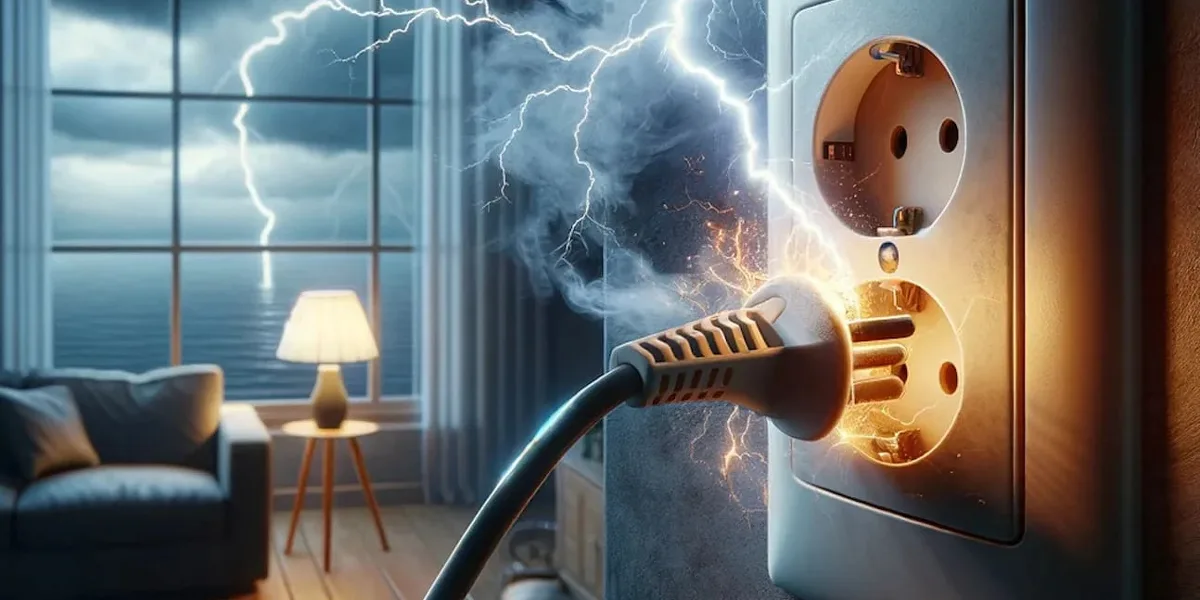
2. LED 칩 소모
고전류는 금색 와이어 연결을 직접 절단하거나 LED 칩을 손상시켜 칩의 부분적 또는 완전한 흑화 및 고장을 유발할 수 있습니다.
3. 점진적인 구성 요소 저하
이러한 유형의 손상은 더 미묘하고 널리 퍼져 있습니다. 고정 장치를 즉시 파괴하지 않는 반복되는 사소한 서지로 내부 반도체 재료에 누적 손상이 발생합니다. 시간이 지남에 따라 조명기들은 설명할 수 없을 정도로 어두워지고, 깜박거리거나, 색상 드리프트를 경험하거나, 운전자로부터 비정상적인 소음을 발생시킬 수 있습니다.
고정 장치의 예상 수명은 50,000~100,000시간에서 1~2년, 또는 그보다 훨씬 적습니다. "표준 이하의 제품"을 구입했다고 가정할 수 있지만 실제 원인은 빈번한 내부 급증일 가능성이 높습니다.
조명기구에 SPD를 추가하면 이점
특히 상업용, 산업용 또는 실외용( 가로등, 투광등, 산업용/광산 조명 등)의 LED 조명 기구는 기존의 고정 장치보다 훨씬 높은 조달 및 설치 비용을 부담합니다. 단일 고정 장치에 대한 손상은 장치 자체 교체 비용뿐만 아니라 특히 고지대 또는 복잡한 환경에서 유지 보수/교체를 위한 상당한 노동 비용을 포함합니다.
SPD 설치 비용은 서지 손상으로 인해 LED 드라이버 또는 전체 고정 장치를 자주 교체하여 발생하는 장기 비용보다 훨씬 저렴합니다. 조명 투자에 대한 중요한 보호 장치입니다.
따라서 LED 조명 시스템(특히 실외, 상업용 및 산업용 조명)을 서지 보호 장치(SPD)로 장착하는 것은 선택 사항이 아니라 필요한 보호 조치입니다. 그것은 다음을 가능하게 합니다:
- 갑작스럽고 값비싼 장비 고장을 방지합니다.
- 숨겨진 점진적인 성능 저하와 수명 단축을 피하십시오.
- 유지 보수 비용을 줄이고 조명 시스템 신뢰성을 향상시킵니다.
- 개별 가정용 고정 장치: 기본 서지 보호 기능이 내장된 고품질 전원 스트립을 사용하십시오.
- 전체 건물 또는 빌라의 경우: 모든 가정용 회로에 트렁크 보호를 제공하기 위해 주 배전반에 Type 2 SPD를 설치합니다.
- 실외 LED 조명기(거리광, 조경등) 및 대형 공장/몰 조명 회로의 경우 해당 구역 배전반 내 조명 회로에 대해 Type 2 SPD를 특별히 설치해야 합니다. 특히 비싸거나 중요한 고정 장치의 경우 세분화된 보호를 위해 고정 장치 내부 또는 터미널에 Type 3 SPD를 추가하는 것을 고려하십시오.
SPD에 투자함으로써 LED 조명 투자가 약속된 수명과 고성능을 제공하여 진정한 가성비를 제공할 수 있습니다.
SPD 등급을 이해하는 방법?
SPD가 존재하는 경우 왜 다른 유형으로 분류합니까? 모든 유형의 서지 위협을 독립적으로 처리할 수 있는 단일 SPD가 없다는 대답이 답입니다.
낙뢰에 의해 생성된 에너지는 내부 스위칭 작업에 의해 생성된 에너지와 크기가 크게 다릅니다. 따라서 효과적인 보호 전략에는 계층화된 시너지 방어 시스템을 구축하는 것이 포함됩니다. 이 개념을 "에너지 조정" 또는 "단위 방전"이라고 합니다. 성의 방어 시스템으로 상상해보십시오.
- 유형 1은 가장 강렬한 정면 공격을 견딜 수 있도록 설계된 견고한 외벽과 게이트 역할을 합니다.
- 유형 2: 성 안의 순찰 경비대가 외벽을 뚫고 내부 교란을 하는 낙오자들에게 연설합니다.
- 유형 3: 왕의 침실 문에 있는 개인 경비원으로, 최종적이고 가장 세련된 보호 층을 제공합니다.
이 세 가지 방어선이 함께 작동할 때만 성(전기 시스템)이 가장 포괄적인 보호를 받을 수 있습니다.
Type 1 SPD: 외부 서지에 대한 첫 번째 방어선
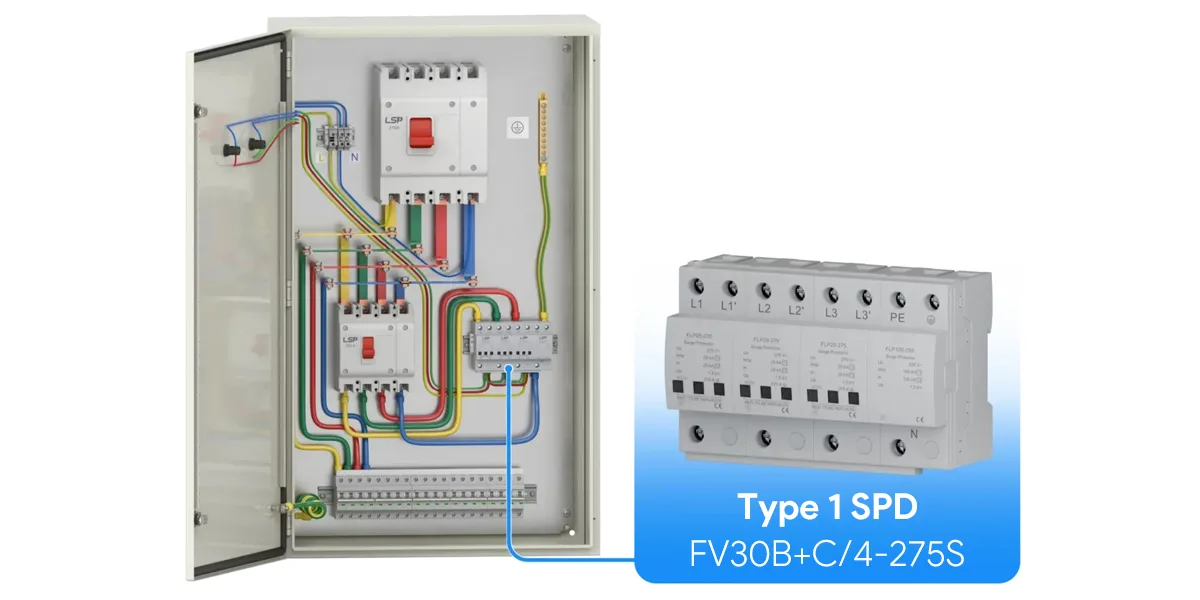
Type 1 SPD는 직접 타격으로 인한 낙뢰 전류의 일부를 전환하도록 설계된 최고 등급의 장치입니다. 국제 표준(예: IEC 61643-1)에 따라 10/350µs의 시뮬레이션된 번개 전류 파형으로 테스트를 견딜 수 있어야 합니다. 이 파형은 장비에 심각한 스트레스를 주는 매우 오랜 시간 동안 직접 번개를 맞이하는 직접적인 낙뢰의 엄청난 에너지를 나타냅니다. 설치 위치: 일반적으로 전력 진입점에 있는 건물의 주요 분배판(MDB) 내에 설치됩니다.
특징: 거대한 낙뢰 전류(종종 수십 킬로암페어)를 방전합니다. 그것의 주요 목적은 전압을 매우 낮은 수준으로 제한하는 것이 아니라 가장 치명적인 초기 타격을 안전하게 "흡수"하는 것입니다.
일반적인 구성 요소: 일반적으로 스파크 갭 또는 가스 배출 튜브를 사용합니다. 이러한 구성 요소는 매우 높은 에너지 충격을 견딜 수 있습니다.
적용 가능한 시나리오: 주로 외부 낙뢰 보호 시스템(예: 피뢰침)이 있는 건물 또는 가공 전력선에서 공급하는 건물에 사용됩니다. 전체 서지 보호 시스템의 기초를 형성합니다.
유형 2 SPD: 1차 보호, 분배 시스템 보호
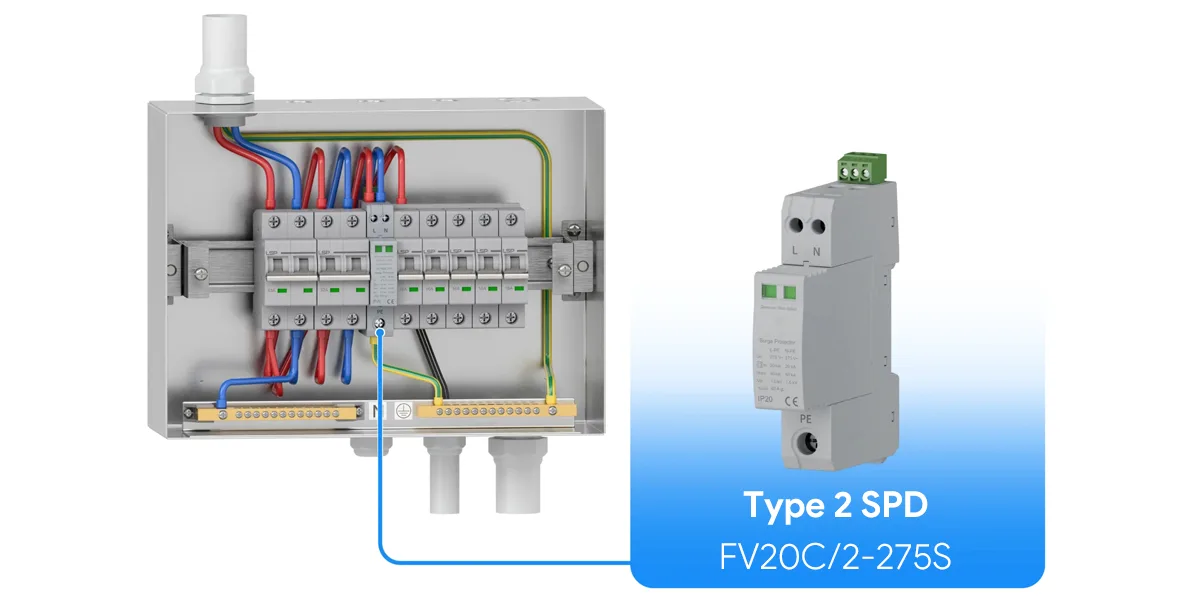
Type 2 SPD는 서지 보호 시스템에서 가장 널리 사용되는 SPD로, 1차 보호 수준으로 사용됩니다. 이들은 8/20µs의 전류 파형을 사용하여 테스트되며, 이는 유형 1 SPD에 의해 제한된 후 전송된 잔류 서지와 내부 스위칭 작업에 의해 생성된 서지를 시뮬레이션합니다.
설치 위치: 특정 바닥, 구역 또는 하중 그룹을 보호하기 위해 하위 분배 보드 내에 설치됩니다.
특징: 내부적으로 생성된 서지와 함께 Type 1 SPD에서 완전히 처리되지 않은 서지 전류를 추가로 제한합니다. 대부분의 가정용 및 상업용 기기(예: 장비 아래의 장비 내 전압 내성)에 안전한 수준으로 전압을 제한합니다.
일반적인 장치: 응답속도와 클램핑 전압 특성이 우수하여 가장 일반적으로 금속 산화물 배리스터(MOV)입니다.
애플리케이션 시나리오: 모든 전기 설비에서 거의 없어서는 안될 보호 장치입니다. 외부 낙뢰 보호 시스템이 없는 소형 건물에서는 1단계 보호 기능을 할 수도 있습니다.
유형 3 SPD: 최종 장치에 대한 정밀 보호
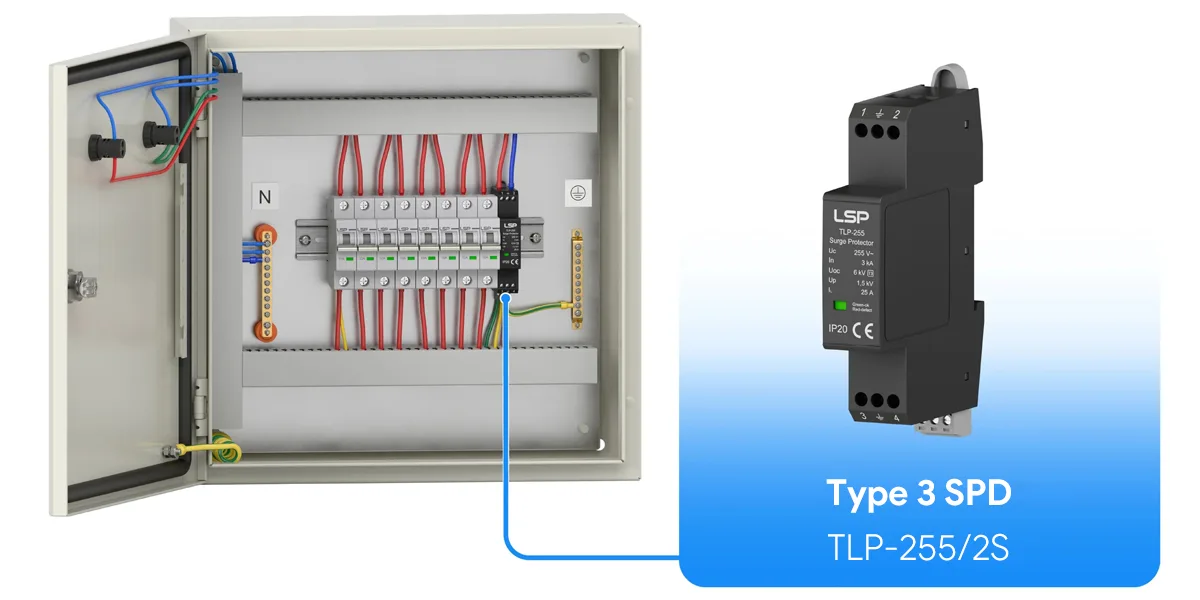
Type 3 SPD는 매우 민감하거나 고가의 최종 장치를 보호하기 위해 특별히 설계된 가장 정교한 수준의 보호 기능을 제공합니다. 2종보다 현저히 낮은 시험 전류 값을 갖는 복합파(1.2/50μs 전압파 및 8/20μs 전류파)를 사용하여 테스트됩니다.
Type 3 SPD는 처음 두 보호 수준을 우회하는 미세 잔류 과전압을 추가로 억제합니다. 에너지가 부족하지만 이러한 전압 스파이크는 장비 수명을 저하시키거나 장기간 축적을 통해 데이터 손상을 유발할 수 있습니다. 절대 단독으로 사용해서는 안 되며 Type 2 SPD의 다운스트림에 설치해야 합니다.
설치 위치:
– SPD 기능이 있는 전원 콘센트(예: 일부 고급 전원 스트립)를 포함한 장비 끝.
– 전용 플러그인 SPD.
– 장비 내부에 내장된 SPD 모듈.
조합 단위: 2+3 Type 2+3 콤비네이션 SPD도 시중에서 판매되고 있습니다. 이들은 두 보호 수준을 단일 모듈에 통합하여 여러 독립형 SPD를 설치하는 것이 비실용적인 시나리오에 편리하고 효율적인 솔루션을 제공합니다.
SPD 시스템을 선택하고 배포하는 방법은 무엇입니까?
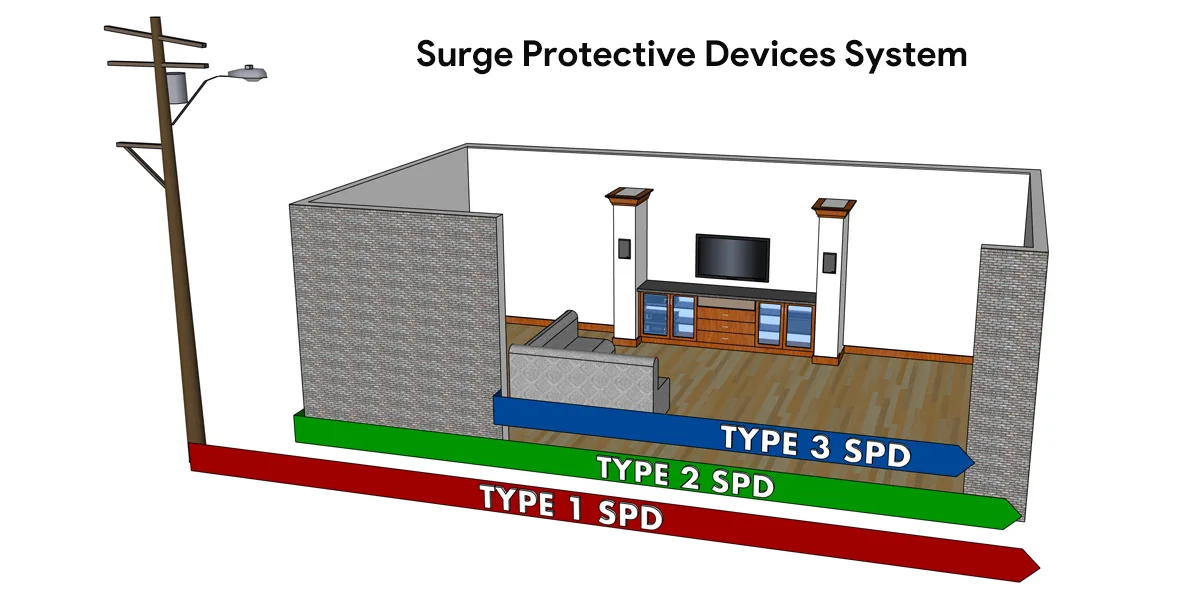
적절한 SPD를 선택하고 조정된 시스템을 구축하는 것은 번개가 자주 발생하거나 상당한 전력 변동이 발생하기 쉬운 환경에서 매우 중요합니다. 적절한 SPD 선택 및 설치는 비용이 많이 드는 수리를 방지할 뿐만 아니라 생산 및 일상 생활의 연속성을 보장하므로 포괄적인 고려가 필요한 기술적 결정입니다.
먼저, 건물의 환경을 평가하십시오: 낙뢰 주파수, 격리 상태, 오버헤드 또는 지하 전원 공급 장치, 구조물에 피뢰침의 존재, 내부 장비의 가치와 감도. 이것은 유형 1 보호가 필요한지 또는 유형 2+3 조합이 충분한지 여부를 결정합니다.
- 계층적 원칙을 따르십시오:
– 외부 낙뢰 보호 시스템 또는 고위험 구역이 있는 건물: 유형 1 → 유형 2 → 유형 3의 완전한 아키텍처 구현.
– 표준 상업 또는 주거용 건물: 주 서비스 입구에 Type 2 SPD를 설치하고 중요한 장비 지점에 Type 3 SPD를 보충합니다.
– 소형 건물 또는 아파트: 서비스 패널 내에 고성능 Type 2 SPD를 설치하고 귀중한 장비를 위해 Type 3 서지 보호 전원 스트립을 사용합니다.
- 전압 보호 수준(UP): 이것은 SPD의 클램핑 전압을 나타냅니다. 값이 낮을수록 보호가 더 잘 됩니다. 보호 장비의 내전압 정격 이하가 되도록 합니다.
- 명목 방전 전류(IN) 및 최대 방전 전류(IMAX): 이것은 SPD가 서지 전류를 분산시키는 능력을 나타냅니다. 값이 높을수록 회복력이 높아집니다.
- 유형 1 SPD의 경우 임펄스 전류(IIMP)에 초점을 맞춥니다.
- 적절한 설치를 보장: SPD 성능은 설치에 따라 크게 달라집니다. 지나치게 긴 리드는 보호를 크게 저하시키는 유도 전압을 생성하므로 접지 리드 길이를 최소화하는 것이 중요합니다. 전용 도구 또는 버스바를 사용하여 SPD를 접지 시스템에 최소 길이로 직접 연결합니다.
- 유지 보수 및 수명: SPD는 소모품입니다. 특히 MOV 기반 SPD는 반복되는 서지 이벤트 후에 점차적으로 저하됩니다. 원격 신호 접점 또는 시각적 경보 창이 있는 SPD를 선택하여 상태를 모니터링하고 적시에 교체할 수 있습니다.
적절한 SPD 유형을 선택하고 조정된 보호 시스템을 구축하는 것은 전기 장비 안전을 보장하고 서비스 수명을 연장하는 데 중요합니다. 그들의 구별과 상호 연결을 이해하면 가정이나 사업을 위한 진정으로 강력한 "전자 방어선"을 구축하는 데 도움이 됩니다. 부록은 다른 SPD 유형을 선택하기 위한 참조 매개변수를 제공합니다.
서지 전류 및 정격 방전 전류에 대한 권장 값 전력선 서지 보호기의 파라미터
| 번개 보호 학년 | C온서머 유닛 | 지점 전기 상자 | 컴퓨터실의 배전함과 보호가 필요한 전자 장비의 포트 | ||
| LPZ0과 LPZ1의 경계 | LPZ1과 LPZ2의 경계 | 후속 보호 구역의 경계 | |||
| 10/350μs | 8/20μs | 8/20μs | 8/20μs | 1.2/50μs 및 8/20μs | |
| 클래스 I 테스트 | 클래스 II 테스트 | 클래스 II ...의 진위 | 클래스 II ...의 진위 | 복합파동 클래스 III 시험 | |
| 임프(카) | (KA) | 나,(ka) | 나,(ka) | U(kv)/ix(kA) | |
| A | ≥20 | ≥80 | ≥40 | ≥5 | ≥10/≥5 |
| B | 15세 이상 | 60세 이상 | 30세 이상 | ≥5 | ≥10/≥5 |
| C | ≥12.5 | ≥50 | ≥20 | 3개 이상 | ≥6/≥3 |
| D | ≥12.5 | ≥50 | 10 이상 | 3개 이상 | ≥6/≥3 |
결론
요약하면 유형 1, 유형 2 및 유형 3 SPD는 각각 고유한 역할을 수행하여 매크로에서 마이크로 수준까지 계층화된 방어 시스템을 형성합니다. 잘 설계된 서지 보호 시스템에 투자하는 것은 하드웨어를 보호할 뿐만 아니라 데이터 보안, 비즈니스 연속성, 생명과 재산 보호에 대한 전략적 투자에 관한 것입니다. 각각의 기능을 이해하고 시너지 효과를 내어 배포함으로써 예측할 수 없는 전기 위협에 대해 전자 자산에 대한 강력한 장벽을 설정할 수 있습니다.
